| Who Are These People?
Do
you remember a time when life was just a little slower and a bit more
relaxed? You can recapture a time like this by participating in this
hobby. Trade in your TV sets and video games for something constructive
and very satisfying. You are building something with your own hands,
a machine capable of working with the same physical laws of this Earth
as the fabric, wood, and wire airplanes of World War I all the way to
today's modern airliners, and everything in between. In this hobby,
your airplane is as true and honest about it's behavior as anything
you'll ever experience. It cannot lie to you nor violate these laws
of nature. You must learn how it wants to behave in the air and adjust
yourself and the machine accordingly.
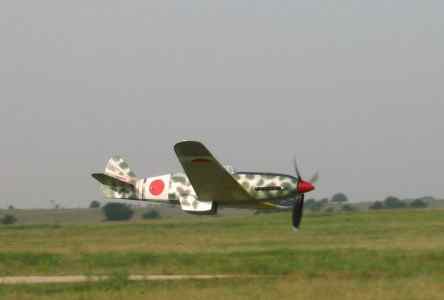
Rubber
powered aircraft are considered freeflight models, in that there are
no control systems for you to use while it is flying. The airplane must
be trimmed (adjusted) in such a way that it flies on it's own, preferably
in nice lazy circles in the sky. You and the others around you become
spectators to the majesty of flight as soon as it is released into the
air. Those of us who are incurable, rejoice at the site of a well trimmed
model in steady flight. The models fly from 30 seconds up to two minutes
and in some cases will actually fly away! These flight times seem trivial
until you experience it. You must learn to give up that urge to control
things in your life when becoming a freeflight model builder.
Rubber
models are constructed using the traditional stick and tissue methods
developed in the 20's and 30's. There are some new advances in some
of the materials and techniques, but the time honored methods are very
much the basis of how they are built. These airplanes are very light,
weighing in at just ounces or grams. The word "pound" is not found in
our vocabulary except to describe a physical act wished upon an uncooperative
airplane. Balsa wood is the chief ingredient found in "stick" and tissue
is a very thin, uniform paper.
 The FLYING ACES Club takes its name
from a magazine popular with kids back in the 30’s and 40’s.
This magazine was a collection of aviation articles, pictures, stories,
and modeling activities. Many of the stories were fictional but also
included current information about what was going on in aviation. The
Pre-war stuff is really interesting to read as the magazine attempted
to assess our air power and the capabilities of our enemies. The old
magazines are collected all over the world and from time to time you
can find them at contests and anywhere rubber modelers get together.
In those days, the world was fascinated by aviation. It was called the
“Golden Age” of aviation due in large part to all of the
pioneering efforts in aircraft design, construction, and performance.
Aircraft were transitioning from the stick, fabric and wire biplanes
of World War I to the slick all-metal monoplanes of World War II. During
this transition, some of the most interesting and beautiful airplanes
were built and aviators were some of the most adventurous and daredevil
people, as evidenced by their incredible journeys and feats. It was
the aviation companies and the military that sponsored model building
as a way to support this fascination and encourage young people to pursue
careers in aviation at a time when the industry was blossoming. Models
were powered by rubber motors in those days because gas engines were
expensive and rare. This problem was worse during the Second World War
when materials became scarce and were needed for the war effort. In
order for a rubber powered airplane to fly with any degree of success,
they had to be built very light. Hence the construction technique of
a framework using thin pieces of balsa, spruce, and bamboo (stick) covered
with a light paper made of wood or bamboo (tissue) made taught by applying
water, dope (a type of paint), or even banana oil. So popular was this
activity that kits and model supplies could be found in most drug and
department stores. The FLYING ACES Club takes its name
from a magazine popular with kids back in the 30’s and 40’s.
This magazine was a collection of aviation articles, pictures, stories,
and modeling activities. Many of the stories were fictional but also
included current information about what was going on in aviation. The
Pre-war stuff is really interesting to read as the magazine attempted
to assess our air power and the capabilities of our enemies. The old
magazines are collected all over the world and from time to time you
can find them at contests and anywhere rubber modelers get together.
In those days, the world was fascinated by aviation. It was called the
“Golden Age” of aviation due in large part to all of the
pioneering efforts in aircraft design, construction, and performance.
Aircraft were transitioning from the stick, fabric and wire biplanes
of World War I to the slick all-metal monoplanes of World War II. During
this transition, some of the most interesting and beautiful airplanes
were built and aviators were some of the most adventurous and daredevil
people, as evidenced by their incredible journeys and feats. It was
the aviation companies and the military that sponsored model building
as a way to support this fascination and encourage young people to pursue
careers in aviation at a time when the industry was blossoming. Models
were powered by rubber motors in those days because gas engines were
expensive and rare. This problem was worse during the Second World War
when materials became scarce and were needed for the war effort. In
order for a rubber powered airplane to fly with any degree of success,
they had to be built very light. Hence the construction technique of
a framework using thin pieces of balsa, spruce, and bamboo (stick) covered
with a light paper made of wood or bamboo (tissue) made taught by applying
water, dope (a type of paint), or even banana oil. So popular was this
activity that kits and model supplies could be found in most drug and
department stores.
 Many
of the modelers who grew up in the 1930's are still active and they
keep the stick and tissue tradition alive by building, flying and promoting
these models. Every one is an avid aircraft ENTHUSIAST
and can identify just about any aircraft known. Many of the classes
of models flown in the Flying Aces events are derived from these early
designs. Not much has changed in the way these models are built or flown
although there have been improvements in covering materials, adhesives,
and especially the rubber which we power them with. The Flying Aces
club boasts a membership of more than 1500 people in
the US and worldwide. They are locally organized into squadrons so they
can meet, fly, and hold contests at their respective field. The local
squadrons are more interested in coming together for flying and fun
and are not too wrapped up on protocol. Members of the Flying
Aces are encouraged to also become members of the Academy
of Model Aeronautics (AMA), a nationally known modeling
association with over a million members. You will be required to be
a member if you fly in some contests, particularly the National Flying
Aces events (Nats) and any AMA sanctioned event. The AMA
provides a larger voice to support our hobby and also provides group
liability insurance coverage for any possible accident incurred while
flying. Included with your AMA membership is a monthly
magazine highlighting the national activities and local events. Many
of the modelers who grew up in the 1930's are still active and they
keep the stick and tissue tradition alive by building, flying and promoting
these models. Every one is an avid aircraft ENTHUSIAST
and can identify just about any aircraft known. Many of the classes
of models flown in the Flying Aces events are derived from these early
designs. Not much has changed in the way these models are built or flown
although there have been improvements in covering materials, adhesives,
and especially the rubber which we power them with. The Flying Aces
club boasts a membership of more than 1500 people in
the US and worldwide. They are locally organized into squadrons so they
can meet, fly, and hold contests at their respective field. The local
squadrons are more interested in coming together for flying and fun
and are not too wrapped up on protocol. Members of the Flying
Aces are encouraged to also become members of the Academy
of Model Aeronautics (AMA), a nationally known modeling
association with over a million members. You will be required to be
a member if you fly in some contests, particularly the National Flying
Aces events (Nats) and any AMA sanctioned event. The AMA
provides a larger voice to support our hobby and also provides group
liability insurance coverage for any possible accident incurred while
flying. Included with your AMA membership is a monthly
magazine highlighting the national activities and local events.
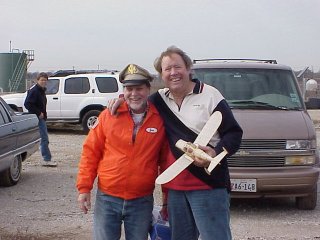 Headquarters
of the Flying Aces publishes one main newsletter titled “Flying
Aces Club News”. This newsletter contains announcements of upcoming
contests, results of contests, and technical information. In addition,
plans are included for building models submitted by FAC members. Most
local squadrons published their own newsletter highlighting local events,
technical information, and (of course) more plans. Many members join
other squadrons to get their newsletters because they are informative
and contain more plans (in case you haven’t caught on by now,
we can’t get enough plans or kits). A year's membership in the
FAC that includes a subscription to the newsletter costs $15.00 per
year. Headquarters
of the Flying Aces publishes one main newsletter titled “Flying
Aces Club News”. This newsletter contains announcements of upcoming
contests, results of contests, and technical information. In addition,
plans are included for building models submitted by FAC members. Most
local squadrons published their own newsletter highlighting local events,
technical information, and (of course) more plans. Many members join
other squadrons to get their newsletters because they are informative
and contain more plans (in case you haven’t caught on by now,
we can’t get enough plans or kits). A year's membership in the
FAC that includes a subscription to the newsletter costs $15.00 per
year.
To sign up write to : FAC-GHQ
3301, Cindy Lane Erie, Pa. 16506. Fortunately, they are attracting
some of the younger population at a rate that will probably keep the
art and technology alive for some time. You can join as many squadrons
as you want.
Class Struggle
There are 30 classes of airplanes recognized by the FAC. They are:
1. FAC PEANUT SCALE
2. FAC RUBBER SCALE
3. FAC JUMBO SCALE
4. FAC GIANT SCALE
5. FAC POWER SCALE
6. FAC PIONEER SCALE
7. GHQ PEANUT SCALE
8. THOMPSON RACE *
9. GREVE RACE *
10. SHELL SPEED DASH
11. AEROL RACE *
12. BENDIX RACE *
13. GOODYEAR RACE *
14. FORMULA RACE *
15. WWI COMBAT *
16. WWII COMBAT *
17. GOLDEN AGE CIVIL SCALE
18. GOLDEN AGE MILITARY
19. MODERN AGE CIVIL SCALE
20. MODERN AGE MILITARY
21. FAC JET CATAPULT SCALE
22. FAC NO-CAL PROFILE SCALE
23. FAC EMBRYO ENDURANCE
24. FAC OLD TIME STICK
25. FAC OLD TIME RUBBER
26. FAC 2-BIT OLD TIME RUBBER
27. FAC OLD TIME GAS REPLICA
28. FAC DIME SCALE
29. FAC OLD TIME KIT SCALE
30. FAC JIMMY ALLEN
31. FAC O.T. PLAN SCALE
* Denotes a mass launch event.
*******
GENERAL FAC RULES *******
The
ideals of the FAC are founded in friendly competition that promotes improvements
to the appearance and flights of our models. The intentions of the GENERAL
FAC RULES are to help the competitor understand the most basic of the
FAC rules that all others are based upon.
- Each entrant must be the builder of the model he / she enters.
- Proxy entries will be allowed at the C.D.'s discretion
- Each builder is permitted only one example of a specific design. There will be no duplicate
"back-up" models allowed.
- Each contestant may enter two different models in any event except the mass launch events where only one model may be
entered per event.
- Three models by three different builders must be
entered with each making a qualifying flight in an official FAC event
for the winner to be credited with a "Kanone."
- All events are for rubber powered models except: FAC Power Scale FAC Old Time Gas Replica FAC Jet
Catapult
- All flight times are in seconds and rounded down to the last full second.
- The minimum official flight time is 20 seconds unless a specific event rule states otherwise.
- A maximum flight is 120 seconds unless a specific event rule states otherwise.
- All events are hand launched unless a specific event rule states otherwise.
- Props that feather or fold at the end of the motor run will not be allowed.
- No condenser paper or other ultra-light covering material may be used to cover any model.
- Foam coverings and foam material used as components within the basic structure is prohibited.
- Foam and other non-balsa materials may be used in the construction of such "add on" parts as air
scoops, radiators, machine guns, etc.
- Engine cowls up to the firewall may be of foam or any other non-balsa material.
- Gear arrangements with a 1:1 ratio may be used in any FAC rubber powered event.
- A gear driven prop may not be powered by more than one rubber motor.
- Binoculars may be used in all events.
A Little Friendly Competition
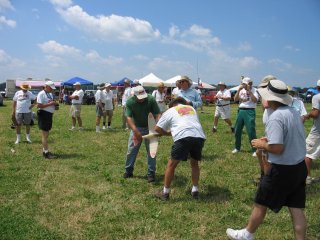 The
world will never improve without competition. I contend that laziness
(not necessity) is the mother of invention and competition improves
and hones it to a fine edge. FAC members like to get together for a
little friendly competition with the outlook for a little recognition
and more importantly, camaraderie. A contest or event is invoked whereby
three or more FAC members compete with a similar class of flying model.
The first place winner is awarded a “Kanone” in the same
way that a German WWI aviator was after scoring a victory. Second, third,
and sometimes fourth place finishers get to bathe in the glory of the
attempt at battle (okay, they get squat). Kanone is German World War
I aviator jargon for “big cannon” which could be thought
of as “hotshot” or “Ace” in America. Once a
German pilot received 16 kanones (eight originally) he was awarded the
“Blue Max”. The Flying Aces club tracks kanones awarded
at the local and national level, and once sixteen are obtained, the
member is awarded a reproduction Blue Max medal as well. This is a good
time to bring up rank within the FAC. When you join, you are commissioned
a First Lieutenant. You become promoted upwards in the ranks as you
accumulate kanones. The
world will never improve without competition. I contend that laziness
(not necessity) is the mother of invention and competition improves
and hones it to a fine edge. FAC members like to get together for a
little friendly competition with the outlook for a little recognition
and more importantly, camaraderie. A contest or event is invoked whereby
three or more FAC members compete with a similar class of flying model.
The first place winner is awarded a “Kanone” in the same
way that a German WWI aviator was after scoring a victory. Second, third,
and sometimes fourth place finishers get to bathe in the glory of the
attempt at battle (okay, they get squat). Kanone is German World War
I aviator jargon for “big cannon” which could be thought
of as “hotshot” or “Ace” in America. Once a
German pilot received 16 kanones (eight originally) he was awarded the
“Blue Max”. The Flying Aces club tracks kanones awarded
at the local and national level, and once sixteen are obtained, the
member is awarded a reproduction Blue Max medal as well. This is a good
time to bring up rank within the FAC. When you join, you are commissioned
a First Lieutenant. You become promoted upwards in the ranks as you
accumulate kanones.
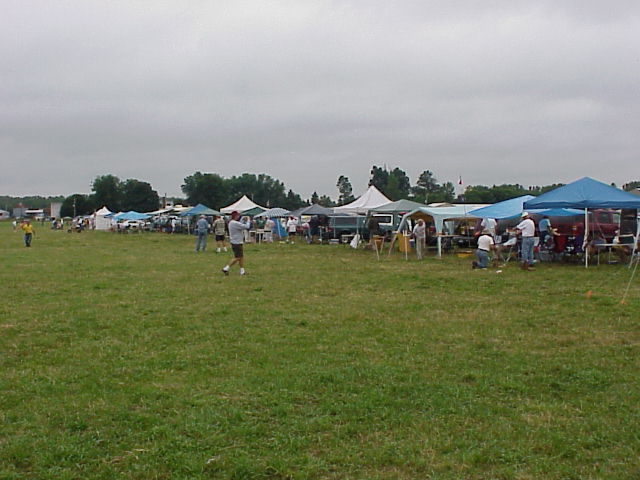 Every two years the FAC hosts a national
competition in Geneseo, NY called the FAC Nats. Competitors come from
all parts of the country and even from international origins to compete
in three days of the toughest flying you’ll find anywhere. The
number of contestants is around 150 who register to fly in all of the
classes available. Most competitors enter from 4 to 8 models depending
on the classes they like. The toughest competition is the one that forms
the basis of the Flying Aces Club, FAC Scale. This class is designed
to encourage modelers to build high quality scale reproductions of actual
aircraft that also fly well. Scale models are judged by a team of seasoned
veterans who evaluate the model on fidelity to the original aircraft
outlines, coloring, and markings. Workmanship and overall quality of
the model are judged as well. Published documentation must be provided
to provide proof of your choice of aircraft and authenticate the color
scheme and markings. With over 150 competitors entering several models
to be judged, approximately 300 to 500 models must be judged in several
hours time. Sometimes, judging takes place out at the field if the number
of entries is small enough. Additional points are accumulated during
the flying phase. Points are awarded for the length of time the aircraft
remains airborne. Bonus points (handicap) are awarded to models that
are more complex or have features that would make them more difficult
to fly. For example, a biplane gets 15 bonus points because planes with
two wings are harder to fly than those with one wing. Flight times range
between 20 to 120 seconds and over, depending on the model and the skill
of the flyer. 20 seconds is the smallest number of seconds to qualify
for an official flight in most cases. Flight times of over 40 seconds
used to be rare but now it takes times in the 90’s to place in
competition these days. Every two years the FAC hosts a national
competition in Geneseo, NY called the FAC Nats. Competitors come from
all parts of the country and even from international origins to compete
in three days of the toughest flying you’ll find anywhere. The
number of contestants is around 150 who register to fly in all of the
classes available. Most competitors enter from 4 to 8 models depending
on the classes they like. The toughest competition is the one that forms
the basis of the Flying Aces Club, FAC Scale. This class is designed
to encourage modelers to build high quality scale reproductions of actual
aircraft that also fly well. Scale models are judged by a team of seasoned
veterans who evaluate the model on fidelity to the original aircraft
outlines, coloring, and markings. Workmanship and overall quality of
the model are judged as well. Published documentation must be provided
to provide proof of your choice of aircraft and authenticate the color
scheme and markings. With over 150 competitors entering several models
to be judged, approximately 300 to 500 models must be judged in several
hours time. Sometimes, judging takes place out at the field if the number
of entries is small enough. Additional points are accumulated during
the flying phase. Points are awarded for the length of time the aircraft
remains airborne. Bonus points (handicap) are awarded to models that
are more complex or have features that would make them more difficult
to fly. For example, a biplane gets 15 bonus points because planes with
two wings are harder to fly than those with one wing. Flight times range
between 20 to 120 seconds and over, depending on the model and the skill
of the flyer. 20 seconds is the smallest number of seconds to qualify
for an official flight in most cases. Flight times of over 40 seconds
used to be rare but now it takes times in the 90’s to place in
competition these days.
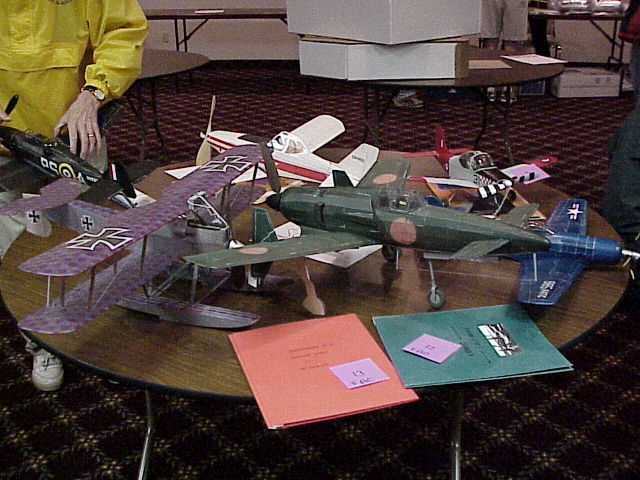 Like I said earlier, competition improves the hobby.
The remaining classes are equally as competitive and require extensive
attention to the smallest detail. The Old Time Rubber and Old Time Rubber
Stick classes are competitive, but not as well attended. Embryo is very
competitive with a large turnout. The racers classes were well attended
this last Nats. The bottom line is, the more the merrier. All aircraft
entered in competition must be constructed using the traditional materials
for the main structural portion of the airframe. There are some exceptions
but they are usually for trim items, wheels, and other small parts.
There are some limitations applied to the airplane, but they are not
extensive. The main idea is to promote stick and tissue construction. Like I said earlier, competition improves the hobby.
The remaining classes are equally as competitive and require extensive
attention to the smallest detail. The Old Time Rubber and Old Time Rubber
Stick classes are competitive, but not as well attended. Embryo is very
competitive with a large turnout. The racers classes were well attended
this last Nats. The bottom line is, the more the merrier. All aircraft
entered in competition must be constructed using the traditional materials
for the main structural portion of the airframe. There are some exceptions
but they are usually for trim items, wheels, and other small parts.
There are some limitations applied to the airplane, but they are not
extensive. The main idea is to promote stick and tissue construction.
Flying
Aces Club - General Headquarters (GHQ)
Lin Reichel
3301 Cindy Lane
Erie, PA 16506
|
 The Lone Star Squadron is a member
of the Flying Aces Club, a society of unique individuals with a common
interest that at times borders on a passion. It is their intent to preserve
and promote the traditional building and flying of free flight stick and
tissue model aircraft. Although competitive at times, the sharing of innovations,
assistance and camaraderie is second nature to all who believe in the
spirit of the FAC.
The Lone Star Squadron is a member
of the Flying Aces Club, a society of unique individuals with a common
interest that at times borders on a passion. It is their intent to preserve
and promote the traditional building and flying of free flight stick and
tissue model aircraft. Although competitive at times, the sharing of innovations,
assistance and camaraderie is second nature to all who believe in the
spirit of the FAC.
 Many
of the modelers who grew up in the 1930's are still active and they
keep the stick and tissue tradition alive by building, flying and promoting
these models. Every one is an avid aircraft ENTHUSIAST
and can identify just about any aircraft known. Many of the classes
of models flown in the Flying Aces events are derived from these early
designs. Not much has changed in the way these models are built or flown
although there have been improvements in covering materials, adhesives,
and especially the rubber which we power them with. The Flying Aces
club boasts a membership of more than 1500 people in
the US and worldwide. They are locally organized into squadrons so they
can meet, fly, and hold contests at their respective field. The local
squadrons are more interested in coming together for flying and fun
and are not too wrapped up on protocol. Members of the Flying
Aces are encouraged to also become members of the
Many
of the modelers who grew up in the 1930's are still active and they
keep the stick and tissue tradition alive by building, flying and promoting
these models. Every one is an avid aircraft ENTHUSIAST
and can identify just about any aircraft known. Many of the classes
of models flown in the Flying Aces events are derived from these early
designs. Not much has changed in the way these models are built or flown
although there have been improvements in covering materials, adhesives,
and especially the rubber which we power them with. The Flying Aces
club boasts a membership of more than 1500 people in
the US and worldwide. They are locally organized into squadrons so they
can meet, fly, and hold contests at their respective field. The local
squadrons are more interested in coming together for flying and fun
and are not too wrapped up on protocol. Members of the Flying
Aces are encouraged to also become members of the  Headquarters
of the Flying Aces publishes one main newsletter titled “Flying
Aces Club News”. This newsletter contains announcements of upcoming
contests, results of contests, and technical information. In addition,
plans are included for building models submitted by FAC members. Most
local squadrons published their own newsletter highlighting local events,
technical information, and (of course) more plans. Many members join
other squadrons to get their newsletters because they are informative
and contain more plans (in case you haven’t caught on by now,
we can’t get enough plans or kits). A year's membership in the
FAC that includes a subscription to the newsletter costs $15.00 per
year.
Headquarters
of the Flying Aces publishes one main newsletter titled “Flying
Aces Club News”. This newsletter contains announcements of upcoming
contests, results of contests, and technical information. In addition,
plans are included for building models submitted by FAC members. Most
local squadrons published their own newsletter highlighting local events,
technical information, and (of course) more plans. Many members join
other squadrons to get their newsletters because they are informative
and contain more plans (in case you haven’t caught on by now,
we can’t get enough plans or kits). A year's membership in the
FAC that includes a subscription to the newsletter costs $15.00 per
year.  The
world will never improve without competition. I contend that laziness
(not necessity) is the mother of invention and competition improves
and hones it to a fine edge. FAC members like to get together for a
little friendly competition with the outlook for a little recognition
and more importantly, camaraderie. A contest or event is invoked whereby
three or more FAC members compete with a similar class of flying model.
The first place winner is awarded a “Kanone” in the same
way that a German WWI aviator was after scoring a victory. Second, third,
and sometimes fourth place finishers get to bathe in the glory of the
attempt at battle (okay, they get squat). Kanone is German World War
I aviator jargon for “big cannon” which could be thought
of as “hotshot” or “Ace” in America. Once a
German pilot received 16 kanones (eight originally) he was awarded the
“Blue Max”. The Flying Aces club tracks kanones awarded
at the local and national level, and once sixteen are obtained, the
member is awarded a reproduction Blue Max medal as well. This is a good
time to bring up rank within the FAC. When you join, you are commissioned
a First Lieutenant. You become promoted upwards in the ranks as you
accumulate kanones.
The
world will never improve without competition. I contend that laziness
(not necessity) is the mother of invention and competition improves
and hones it to a fine edge. FAC members like to get together for a
little friendly competition with the outlook for a little recognition
and more importantly, camaraderie. A contest or event is invoked whereby
three or more FAC members compete with a similar class of flying model.
The first place winner is awarded a “Kanone” in the same
way that a German WWI aviator was after scoring a victory. Second, third,
and sometimes fourth place finishers get to bathe in the glory of the
attempt at battle (okay, they get squat). Kanone is German World War
I aviator jargon for “big cannon” which could be thought
of as “hotshot” or “Ace” in America. Once a
German pilot received 16 kanones (eight originally) he was awarded the
“Blue Max”. The Flying Aces club tracks kanones awarded
at the local and national level, and once sixteen are obtained, the
member is awarded a reproduction Blue Max medal as well. This is a good
time to bring up rank within the FAC. When you join, you are commissioned
a First Lieutenant. You become promoted upwards in the ranks as you
accumulate kanones.